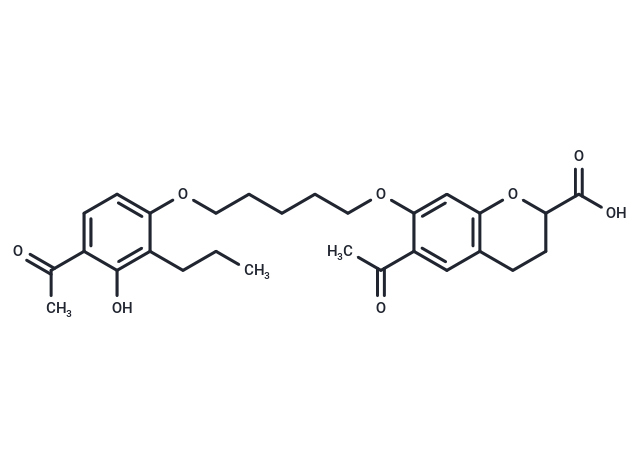Shopping Cart
- Remove All
 Your shopping cart is currently empty
Your shopping cart is currently empty

Ablukast (Ro 23-3544) is a leukotriene receptor antagonist that functions as an anti-asthmatic.

| Pack Size | Price | Availability | Quantity |
|---|---|---|---|
| 1 mg | $41 | In Stock | |
| 5 mg | $116 | In Stock | |
| 10 mg | $188 | In Stock | |
| 25 mg | $371 | In Stock | |
| 50 mg | $521 | In Stock | |
| 100 mg | $708 | In Stock | |
| 200 mg | $953 | In Stock | |
| 1 mL x 10 mM (in DMSO) | $128 | In Stock |
| Description | Ablukast (Ro 23-3544) is a leukotriene receptor antagonist that functions as an anti-asthmatic. |
| Alias | Ro 23-3544 |
| Molecular Weight | 498.56 |
| Formula | C28H34O8 |
| Cas No. | 96566-25-5 |
| Smiles | CCCc1c(O)c(ccc1OCCCCCOc1cc2OC(CCc2cc1C(C)=O)C(O)=O)C(C)=O |
| Relative Density. | 1.219g/cm3 |
| Storage | Powder: -20°C for 3 years | In solvent: -80°C for 1 year | Shipping with blue ice. | |||||||||||||||||||||||||||||||||||
| Solubility Information | DMSO: 60 mg/mL (120.35 mM), Sonication is recommended. | |||||||||||||||||||||||||||||||||||
Solution Preparation Table | ||||||||||||||||||||||||||||||||||||
DMSO
| ||||||||||||||||||||||||||||||||||||

Copyright © 2015-2025 TargetMol Chemicals Inc. All Rights Reserved.